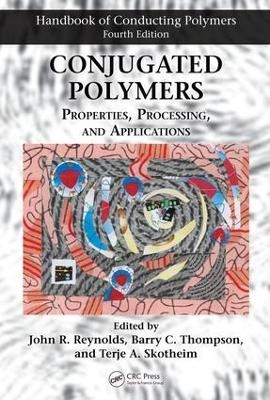
Conjugated Polymers
CRC Press (Verlag)
978-1-138-06570-3 (ISBN)
The Fourth Edition of the Handbook of Conducting Polymers, Two-Volume Set continues to be the definitive resource on the topic of conducting polymers. Completely updated with an extensive list of authors that draws on past and new contributors, the book takes into account the significant developments both in fundamental understanding and applications since publication of the previous edition.
One of two volumes comprising the comprehensive Handbook, Conjugated Polymers: Properties, Processing, and Applications features new chapters focusing on these topics within conducting polymers. It discusses properties and characterization, including thermoelectric and mechanical properties, as well as processing and morphology, covering such topics as thermal phase behavior influence on optoelectronic properties, effect of miscibility on organic solar cells, and more. Finally, the book discusses applications, including the use of conducting polymers in stretchable electronics, electrochemical capacitors, and biomedical applications.
Aimed at researchers, advanced students, and industry professionals working in materials science and engineering, this book covers properties, processing, characterization, and morphology in a wide-ranging listing of comprehensive chapters authored by an international team of experts.
Terje A. Skotheim is the founder of Lightsense and has a successful record in developing new technologies and launching new products in fields as diverse as advanced lithium-sulfur batteries, MEMS devices, photovoltaic cells, and biosensors, through several startups. His research interests have spanned across several disciplines in materials science, including conducting polymers, semiconductors, ion conductors and diamond-like carbon. He has held research positions and co-founded companies in Europe and the US, and was head of the conducting polymer group at DOE’s Brookhaven National Laboratory before launching his career as an entrepreneur. He received his B.S. in physics from the Massachusetts Institute Technology and his Ph.D. in physics from the University of California at Berkeley. John R. Reynolds, a native Californian, obtained his B.S. in Chemistry at San Jose State University (1979) followed by his M.S. (1982) and Ph.D. (1984) in Polymer Science and Engineering at the University of Massachusetts. He became interested in the field of conducting and electroactive polymers through a position with the IBM Research Laboratories in the late 1970s. After developing his own research effort at The University of Texas at Arlington (1984-1991), he moved to the University of Florida where he was a Professor of Chemistry and Associate Director of the Center for Macromolecular Science and Engineering until Spring 2012, when his group moved to Georgia Tech where he is a Professor of Chemistry and Biochemistry, and Materials Science and Engineering. He serves as Director of the Georgia Tech Polymer Network (GTPN) and is a member of the Center for Organic Photonics and Electronics (COPE) management team. Barry C. Thompson was born in Milwaukee, Wisconsin in 1977 and moved to Gallipolis, Ohio at a young age, where he attended elementary and high school. Barry then attended the University of Rio Grande in Rio Grande, Ohio, where he majored in Chemistry and Physics and minored in Mathematics. After completing his undergraduate studies at Rio Grande, Barry moved to the University of Florida to pursue a Ph.D. in Chemistry with Prof. John R. Reynolds as an NSF Graduate Research Fellow. During his Ph.D. studies, Barry focused on the design and synthesis of electroactive conjugated polymers for electrochromic and photovoltaic applications. Upon completion of his Ph.D. in 2005, Barry moved to Prof. Jean Fréchet’s lab at UC Berkeley to further pursue his interests in polymer-based photovoltaics as an ACS-PRF Postdoctoral Fellow. After a three-year stay at Berkeley, Barry moved to the University of Southern California, Department of Chemistry and Loker Hydrocarbon Research Institute as an Assistant Professor of Chemistry. Barry was promoted to Associate Professor with Tenure in 2015.
Properties and Characterization of Conjugated Polymers. Photophysics. Conducting Polymers. Transport in Conjugated Polymers. Thermoelectrics. Electrochemistry of Conducting Polymers. Electrochromic Polymers. Mechanical Properties of Conjugated Polymers. Photorefractive Polymers. Optoelectronic Polymers. Processing and Morphology of Conjugated Polymers. Printing. Thermal Processing. Morphology Evolution. Conducting Polymer Composites. Oligomer Based Film Structure. Thin Film Structure. Soft X-ray Structural Characterization (RoXS). OFET Applications. Polymers for Organic Photovoltaics. Organic Photovoltaics Architecture. Organic Photovoltaics. Applications of Conjugated Polymers. Conjugated Polymer Sensors. Electrochromic Polymer Devices. Electronic Skin. Electrochemical Devices. Bio- Applications. Redox Active Polymers. Supercapacitors. Actuators and Artificial Muscles. Industrial Status of PEDVT. Aerospace Applications.
| Erscheinungsdatum | 05.04.2019 |
|---|---|
| Reihe/Serie | Handbook of Conducting Polymers, Fourth Edition |
| Zusatzinfo | 23 Tables, black and white; 56 Illustrations, color; 363 Illustrations, black and white |
| Verlagsort | London |
| Sprache | englisch |
| Maße | 178 x 254 mm |
| Gewicht | 1882 g |
| Themenwelt | Naturwissenschaften ► Chemie ► Organische Chemie |
| Technik ► Elektrotechnik / Energietechnik | |
| Technik ► Umwelttechnik / Biotechnologie | |
| ISBN-10 | 1-138-06570-6 / 1138065706 |
| ISBN-13 | 978-1-138-06570-3 / 9781138065703 |
| Zustand | Neuware |
| Haben Sie eine Frage zum Produkt? |
aus dem Bereich


